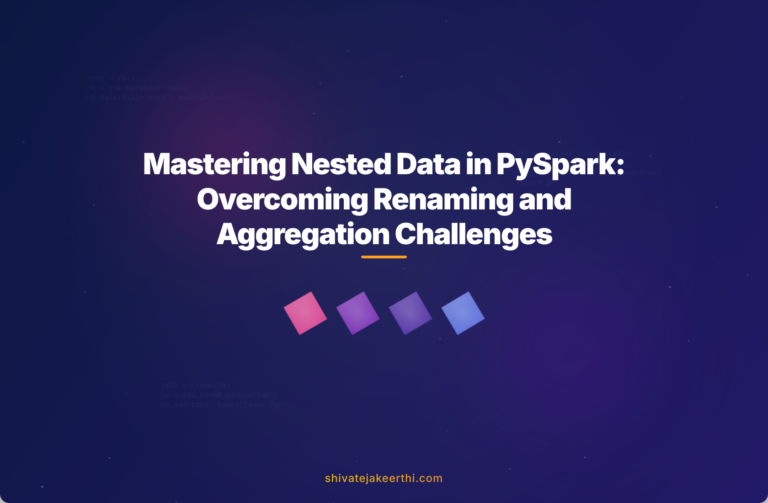When working with big data transformations, PySpark stands out as one of the most powerful tools available for developers and data engineers. Its ability to efficiently process large datasets makes it an ideal choice, especially when handling complex data transformations. However, dealing with nested data structures in PySpark often poses unique challenges, particularly related to column renaming and aggregation issues.
If you’ve ever spent hours trying to rename nested columns without triggering unexpected aggregations, you’re not alone. Let’s explore how you can effectively handle nested data structures in PySpark, avoiding common pitfalls related to aggregation errors.
Understanding Input Data Format and Challenges
First, let’s visualize a real-world scenario. Imagine you’re working with data representing customer transactions. Your data might come structured in JSON format, containing nested fields such as customer details, order details, and product attributes.
Here’s an example illustrating how your input data might look:
{
"customerId": "C123",
"orderDetails": {
"orderId": "O456",
"date": "2023-09-01",
"product": {
"productId": "P789",
"productName": "Wireless Mouse"
}
}
}
At first glance, this data looks straightforward enough. However, when you attempt to rename or flatten these nested columns using PySpark, you might encounter unexpected aggregation issues. Such issues usually manifest as errors when running your Spark transformation or unintended aggregation results due to incorrect schema or data handling.
The Desired Output Format
Ideally, the transformed data should clearly map each nested field to a descriptive, easily readable column name. The transformation should produce a flattened schema similar to:
customerId | orderId | orderDate | productId | productName
-----------|---------|-------------|-----------|------------
C123 | O456 | 2023-09-01 | P789 | Wireless Mouse
This structure improves readability, simplifies querying, and is optimal for analytical operations.
Creating Schema to Load Nested Data
One crucial step to correctly handling nested data is defining an explicit custom schema using StructType and StructField. Explicitly defining the schema allows Spark to accurately parse nested JSON structures, avoiding common pitfalls associated with automatically inferred schemas:
from pyspark.sql.types import StructType, StructField, StringType
schema = StructType([
StructField('customerId', StringType(), True),
StructField('orderDetails', StructType([
StructField('orderId', StringType(), True),
StructField('date', StringType(), True),
StructField('product', StructType([
StructField('productId', StringType(), True),
StructField('productName', StringType(), True)
]))
]))
])
Explicit schema definition helps avoid ambiguity and ensures the data is parsed correctly. It significantly reduces the likelihood of schema-mismatch errors or issues during aggregation or renaming.
Analyzing Automatically Inferred Schema Limitations
Sometimes developers rely on Spark’s default schema inference capabilities. Although convenient, schema inference has its limitations. Spark parses only a subset of your data to infer the schema, potentially missing details or nesting structures deeper in your dataset.
Relying solely on inferred schemas can lead you towards unnoticed schema issues, especially if your nested data varies across records or fields contain null or missing values. Such discrepancies can create unexpected challenges during transformations.
Common Issue: Aggregation Error During Renaming
A common scenario occurs when renaming nested columns directly using aggregation functions like explode() to flatten data. Such operations might produce unintended aggregation. For instance:
df.select(
"customerId",
"orderDetails.orderId",
"orderDetails.date",
"orderDetails.product.productId",
"orderDetails.product.productName"
).groupBy("customerId").agg(... some aggregation ...)
This might inadvertently cause aggregation issues if you’re unintentionally modifying schema structures or misaligning nested fields. As a consequence, the data might be duplicated, missing, or aggregated incorrectly, severely impacting the accuracy of downstream analytics and processing tasks.
A Closer Look at the Current Transformation Problem
Let’s say you’ve performed the transformation like below:
df_flat = df.selectExpr(
"customerId",
"orderDetails.orderId as orderId",
"orderDetails.date as orderDate",
"orderDetails.product.productId as productId",
"orderDetails.product.productName as productName"
)
While this code seems straightforward, the aggregation-related issue arises when further analytical operations or Python-based transformations are applied. You might see errors related to aggregation functions or groupings failing unexpectedly.
How to Fix Nested Column Renaming Issues in PySpark
To overcome these aggregation issues, consider explicitly flattening the nested structures before aggregation. The approach typically involves these steps:
- Use the withColumn() method with dot notation to explicitly pull nested fields into new columns.
- Avoid performing aggregation simultaneously with the renaming or flattening.
- Always create intermediate flattened DataFrames separately before applying groupBy and aggregations.
The Corrected PySpark Transformation Approach
Below is a robust code snippet demonstrating the effective way to handle nested structures:
from pyspark.sql.functions import col
df_flattened = df \
.withColumn("orderId", col("orderDetails.orderId")) \
.withColumn("orderDate", col("orderDetails.date")) \
.withColumn("productId", col("orderDetails.product.productId")) \
.withColumn("productName", col("orderDetails.product.productName")) \
.drop("orderDetails")
# Now aggregation can be safely applied
df_aggregated = df_flattened.groupBy("customerId").count()
In this method, we first flatten nested columns into standalone columns. After the flattening step, any subsequent aggregation is straightforward, predictable, and behaves reliably.
This method ensures no ambiguity in column references and clarity in transformations. Separating flattening and aggregation into distinct steps provides greater operational clarity, easier debugging, and stable transformations.
Why This Solution Works Best
This revised approach greatly simplifies debugging, reduces confusion among developers, and eliminates unintended side effects of complex operations. It also leverages standard PySpark methods familiar to many developers, ensuring your data transformation pipelines remain maintainable and error-free.
Moreover, explicitly creating flattened columns using the withColumn() method is more robust and less error-prone than using selectExpr or aggregation with nested column references.
By explicitly flattening nested columns beforehand, you enable clean and straightforward aggregation operations. This small change significantly enhances the reliability of your Spark transformations, making your data processing pipelines robust for large-scale, production operations.
Understanding these intricacies of nested data management in PySpark is critical, enabling data engineers and analysts to efficiently and accurately transform and analyze big datasets. Implementing best practices like explicit schema definition and avoiding combined renaming-aggregation steps provides quality assurance in highly dynamic data processing environments.
Have you come across similar issues in PySpark, and do you have alternate approaches you’d prefer? Share your thoughts or experiences in the comments—together, we can continue to improve how we handle nested data effectively.



0 Comments